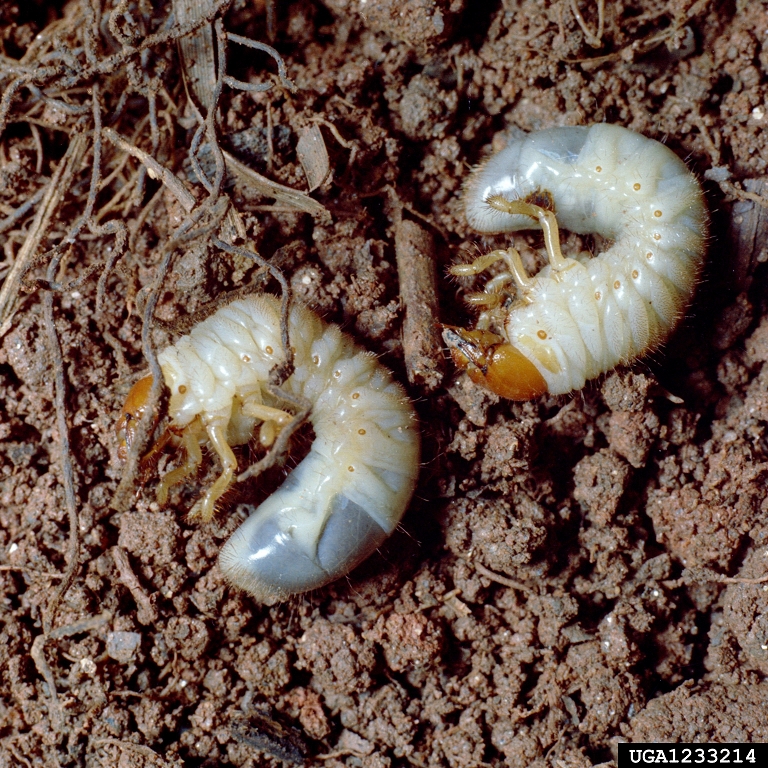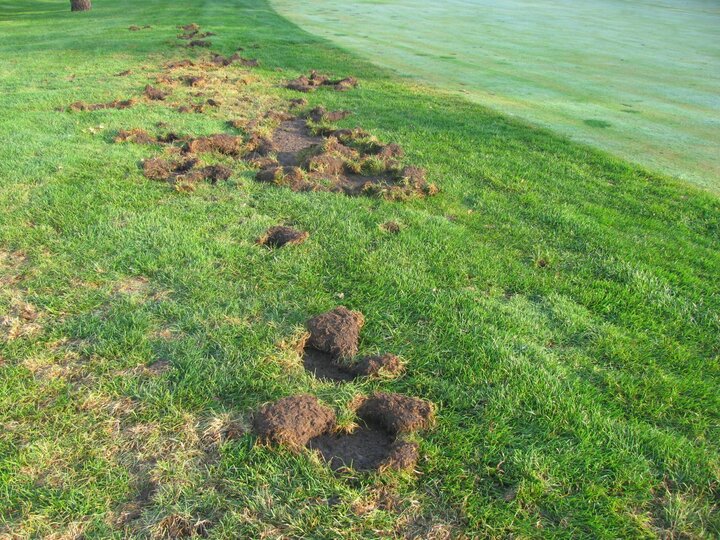Sarah Browning, Extension Educator

May/June beetle larvae. Image from Clemson University - USDA Cooperative Extension Slide Series, Bugwood.org.
Almost every gardener has seen grub larvae in the soil while installing new plants or tilling the vegetable garden. The term "white grub" actually encompasses the larval stage of several scarab beetles, the most common and most damaging, being the June beetle/masked chafer and the Japanese beetle. Less well-known, are the May/June beetle and green June beetle. All have a grub larval stage that can cause damage to turfgrass. The grubs are off white, with six legs located just behind their reddish-brown head and are usually found curled into a "C" shape in the soil.
Adult June beetles are stout bodied, oval-shaped insects, about 1/2 inch in length, and dark yellow to light brown in color. They are most active at night, often flying around lights. Unlike other scarab beetles, June beetles do not feed on plants as adults.
Japanese beetle adults are slightly smaller, only 3/8 inches in length, with a dark metallic green head and coppery-brown body. They also have 5 tufts of white hairs on the sides of their abdomen. Both masked chafers and Japanese beetles have a 1-year lifecycle. Japanese beetles do feed as adults and can cause severe damage to a wide range of landscape plants. Roses, oaks and cherries are a few of their preferred plants and can suffer significant defoliation.
Do all lawns have grub problems?
No. Newly established lawns and low maintenance lawns usually have few problems with grubs. Turf-type tall fescue lawns also have few problems and seldom need preventive treatment. Kentucky bluegrass lawns maintained at a high level with frequent fertilizer and water applications are most prone to attack.

I found a couple grubs in my lawn. Do I need to apply control?
No. Masked chafers are Nebraska native insects, so a few white grubs are natural and common. At this level, control is not needed.
The damage threshold for turfgrass by masked chafer larvae is 8-10 white grubs per square foot of lawn; 10 grubs per square foot for Japanese beetle grubs.
What does grub damage look like in my lawn?
White grubs feed on turf and ornamental plant roots and other organic matter in the soil. They damage grass by destroying roots and eliminating plants’ ability to absorb water from the soil. Damage is usually at its worst in late July and early August if high insect numbers are present and not controlled.
Initially, affected areas of grass turn brown and die. The damage may appear to be drought injury or even a disease such as summer patch. But close inspection of affected areas shows the turf can be pulled back easily, like a carpet, and numerous white grub larvae are found underneath. Severe infestations can result in extensive turf damage.
Later in the season, September and October, birds and other types of wildlife can cause further damage as they pull up the grass to find juicy, fat mature grubs.
When is the best time to apply control to protect my lawn?
If your lawn has a history of grub problems an application for preventive control should have been made from mid to late June. Imidacloprid (Merit), chlorantraniliprole (Acelepryn) and halofenozide (Mach 2) all provide excellent control. However, at this point in the season - late July - the effectiveness of these products will be reduced.
In addition to the products mentioned above, commercial lawn professionals may use clothianidin (Arena) or thiamethoxam (Meridian) for control. All products are very effective against young grubs.

Yikes! It's August and I missed the June window for grub control but now have damage appearing. What can I do?
If grub control is needed in August or September, carbaryl (Sevin) or trichlorfon (Dylox) provide the best control due to their higher kill rate against mature white grubs.
Any tips for making my grub control application?
White grub infestations also tend to be localized to preferred locations in the landscape, such as a sunny, irrigated slope or turfgrass underneath a yard light where adults congregate at night. Distribution of damage throughout the lawn will usually be spotty instead of even or uniform. Spot applications of grub control products can be made to areas with a history of attack; its often not necessary to apply products to the entire yard.
Be sure to water-in grub control products after application to move the insecticide down into the soil where the insects are located.
As with any pesticide application, follow all label directions.
For more information, refer to Managing White Grubs in Turfgrass from Purdue University.
Images:
- Japanese beetles grubs feeding on turf roots. Image by Jody Green, Nebraska Extension.
- Grub feeding on roots causes browning of turf. A closer look reveals the turf can easily be pulled or rolled back like carpet. Image by John Fech, Nebraska Extension.
Search Our Archive
Associated Video
White Grub Control
Nebraska Extension Entomologist Jonathan Larson talks about how to control white grubs in turf, both preventative and curative tips. June 1, 2018